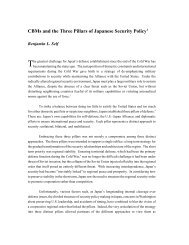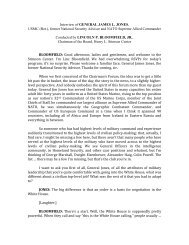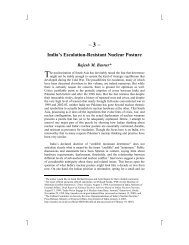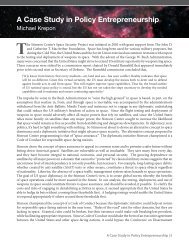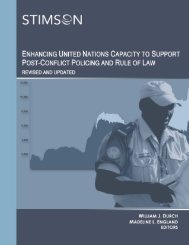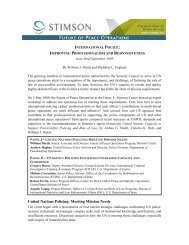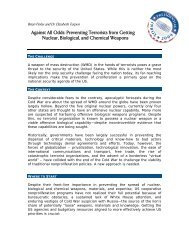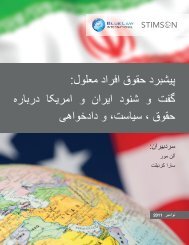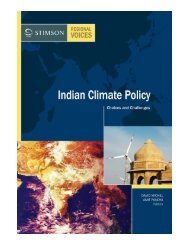Islam and Politics - The Stimson Center
Islam and Politics - The Stimson Center
Islam and Politics - The Stimson Center
Create successful ePaper yourself
Turn your PDF publications into a flip-book with our unique Google optimized e-Paper software.
84 | Faith, Justice, <strong>and</strong> Violence: <strong>Islam</strong> in Political Context<br />
zation, resistance, <strong>and</strong> anti-Western sentiment in this volatile region. <strong>The</strong>y also offer a<br />
complex, ambiguous, <strong>and</strong> surprising underst<strong>and</strong>ing of the doctrine of jihad.<br />
<strong>The</strong> ANP is the successor <strong>and</strong> proud guardian of the legacy of the colonial-era Khudai<br />
Khidmatgar, the “Army of God.” This was an early 20th century mass movement of anti-<br />
British resistance, led by the charismatic <strong>and</strong> deeply devout Khan Abdul Ghaffar Khan, a<br />
Pathan notable from a l<strong>and</strong>owning family.<br />
<strong>The</strong> movement seemed at first blush to reflect the image of the Pathan as a proud <strong>and</strong><br />
warlike people, resistant to foreign occupation <strong>and</strong> influence, <strong>and</strong> deeply motivated by<br />
religious faith <strong>and</strong> identity. It was on those grounds that the British sought to demonize it<br />
<strong>and</strong> to justify their harsh measures against its followers <strong>and</strong> leaders. Khudai Khidmatgar<br />
soldiers wore military uniforms <strong>and</strong> drilled like an army. Using rhetoric replete with references<br />
to jihad <strong>and</strong> martyrdom, the movement sought expulsion of the British, as had previous<br />
religious movements, including the insurrection led by the so-called “mad mullah,”<br />
Mullah Mastun.<br />
However, while it reflected its historical antecedents <strong>and</strong> cultural milieu in mixing the<br />
practice of spirituality, martial language, <strong>and</strong> militant resistance, the Khudai Khidmatgar<br />
offered one startling innovation. As a matter of religious conviction <strong>and</strong> ethical choice, it<br />
was an army with no weapons. While not ready to offer violence, it did not shrink from<br />
death, martyrdom, <strong>and</strong> resistance by all unarmed means. Its br<strong>and</strong> of militancy remains<br />
legendary, <strong>and</strong> its soldiers’ commitment to martyrdom was deadly serious: many risked<br />
<strong>and</strong> some suffered death, wounds, <strong>and</strong> imprisonment while resisting armed colonial constabulary.<br />
In urging villagers to resist a ban on freedom of association, Khan used the metaphor of<br />
war. “Pay no attention to the order,” he exhorted. “Be ready <strong>and</strong> come out to the nonviolent<br />
battlefield. Non-violent war means a kind of war your ancestors fought fourteen<br />
hundred years ago. Show the people you are their descendants … Rule yourselves, <strong>and</strong> as<br />
long as you live, do not submit to the rule of anybody else. Be prepared <strong>and</strong> free yourselves<br />
from this oppressive rule. If you perish on the battlefield, what does it matter? Everyone<br />
must die.” 6<br />
<strong>The</strong> last pair of slogans would have had tremendous echoes for his listeners in their lessons<br />
on the Quran <strong>and</strong> on the accounts of the words of the Prophet before battles with the<br />
enemies of the first Muslim community. Elsewhere Khan described the evolution of his<br />
underst<strong>and</strong>ing of the political duties of a Muslim:<br />
6<br />
Eknath Easwaran, Badshah Khan, Non-violent Soldier of <strong>Islam</strong> (Tomales, CA: Nilgiri Press,1984).



